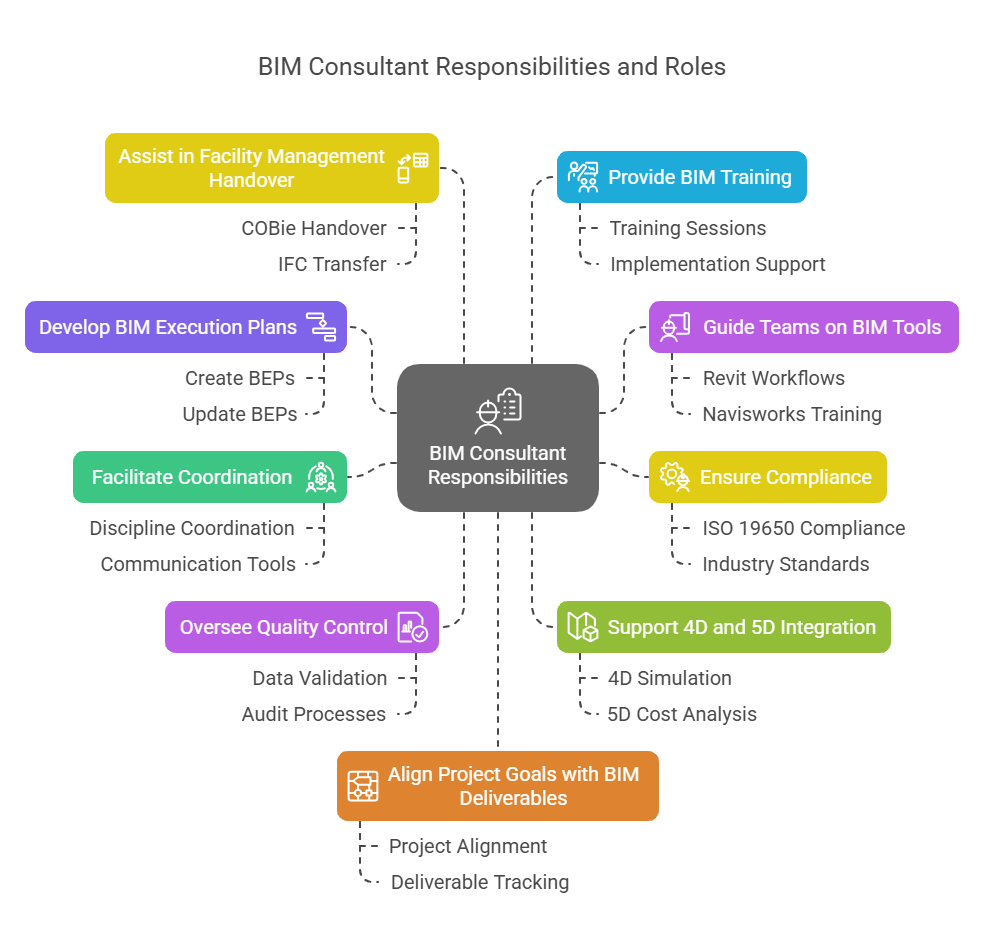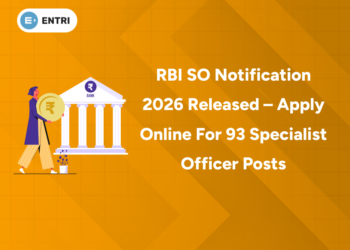Table of Contents
If you’re preparing for a BIM Consultant role, you’re likely searching for the most relevant BIM Consultant interview questions that can help you understand what companies are looking for. This blog covers 30 handpicked questions and answers — from fundamental BIM concepts to advanced coordination strategies — to give you the confidence to ace your next interview. Whether you’re switching roles, stepping up from a BIM Modeler position, or just polishing your knowledge, this guide will help you get interview-ready.
BIM Consultant Interview Questions & Answers
Introduction
BIM Consultants play a strategic role in driving digital adoption across the construction industry. Unlike BIM Modelers who primarily focus on model creation, BIM Consultants lead the planning, execution, and management of BIM strategies at an organizational or project level.
Here’s why BIM Consultants are in demand:
-
Develop BIM Execution Plans (BEPs)
-
Guide teams on Revit, Navisworks, BIM 360, and IFC workflows
-
Ensure compliance with industry standards like ISO 19650
-
Facilitate coordination between disciplines
-
Oversee quality control, audits, and data validation
-
Support 4D and 5D BIM integration
-
Assist in facility management handover (COBie, IFC)
-
Provide BIM training and implementation support
-
Align project goals with BIM deliverables
-
Play a vital role in the full project lifecycle
This guide covers the most common BIM Consultant interview questions and answers — from basic principles to advanced coordination and compliance techniques — to help you prepare with confidence.
Get Career-Oriented BIM Certification Course with Expert Mentors! Get a free demo here!
Master BIM and Elevate Your Career – Enroll Today!
Stay ahead in the construction and design industry with our comprehensive BIM Course! Learn Building Information Modeling (BIM) from experts, gain hands-on experience with top software, and boost your career prospects. Join now and become a certified BIM professional!
Know MoreBIM Consultant Interview Questions and Answers: Basic Level
1. What is the role of a BIM Consultant?
A BIM Consultant is responsible for implementing and managing BIM processes across a project or organization.
-
Creates BIM Execution Plans (BEPs)
-
Ensures team alignment with standards
-
Supports project collaboration and coordination
-
Advises on tools, workflows, and data requirements
2. What is BIM and how is it different from traditional CAD?
BIM is a data-rich process for planning, designing, constructing, and managing buildings.
| Feature | CAD | BIM |
|---|---|---|
| Output | 2D drawings | Intelligent 3D models with metadata |
| Collaboration | Often isolated | Cloud-based, integrated workflows |
| Data | Geometry only | Includes geometry + functional data |
| Lifecycle | Design-focused | Covers full lifecycle (design to FM) |
3. What is a BIM Execution Plan (BEP)?
A BEP outlines how BIM will be implemented and managed.
-
Defines project goals, standards, and deliverables
-
Establishes responsibilities, tools, and workflows
-
Sets protocols for model sharing, naming, and coordination
4. What software should a BIM Consultant be proficient in?
-
Revit (modeling)
-
Navisworks (clash detection)
-
BIM 360 / ACC (cloud collaboration)
-
Solibri (model checking)
-
Excel (data and COBie workflows)
-
IFC viewers (for openBIM workflows)
5. What is ISO 19650?
An international standard for managing information over a project’s lifecycle using BIM.
-
Promotes structured collaboration
-
Standardizes file naming, data delivery, and metadata
-
Supports consistent and reliable data exchange
6. What are Levels of Development (LOD)?
Defines model element detail at each stage:
-
LOD 100 – Conceptual
-
LOD 200 – Approximate geometry
-
LOD 300 – Detailed design
-
LOD 400 – Construction-ready
-
LOD 500 – As-built
7. What is COBie?
COBie (Construction-Operations Building information exchange) is a format for handing over asset data.
-
Delivered in spreadsheet or IFC format
-
Contains equipment names, warranties, maintenance data
-
Used by facility managers after construction
8. What is the importance of classification systems in BIM?
They standardize element categorization.
-
Examples: OmniClass, UniClass, MasterFormat
-
Supports scheduling, cost estimating, and FM integration
9. What is the Common Data Environment (CDE)?
A centralized platform to store, manage, and share project data.
-
Ensures version control
-
Supports document workflows
-
Examples: BIM 360, Aconex, ProjectWise
10. What is IFC and why is it important?
Industry Foundation Classes (IFC) is an open, neutral BIM file format.
-
Supports interoperability between BIM tools
-
Maintains geometry and data integrity
-
Ideal for openBIM projects
Get Career-Oriented BIM Certification Course with Expert Mentors! Get a free demo here!
BIM Consultant Interview Questions and Answers: Intermediate Level
11. What are the key components of a BEP?
-
Project goals and BIM uses
-
Roles and responsibilities
-
LOD and model structure
-
File naming and exchange protocols
-
Coordination and QA processes
12. How do you conduct a BIM audit?
-
Check naming conventions and folder structures
-
Validate model geometry and metadata
-
Identify errors, warnings, and performance issues
-
Run clash detection and parameter checks
-
Prepare audit reports and suggest improvements
13. How do you manage model coordination?
-
Link architectural, structural, and MEP models
-
Use shared coordinates and view templates
-
Run regular clash detections (e.g., Navisworks)
-
Log issues and track resolutions
-
Hold weekly coordination meetings
14. What is the purpose of shared parameters in Revit?
-
Allow consistent data tagging across families and projects
-
Stored in external text files
-
Essential for COBie exports and custom scheduling
15. How do you ensure consistency across BIM deliverables?
-
Use templates and standard naming
-
Apply view templates and filters
-
Follow LOD and object naming protocols
-
Conduct QA/QC checks before submission
16. What are federated models?
Federated models combine multiple discipline-specific models (e.g., architecture, MEP).
-
Maintains model separation
-
Supports coordination and clash detection
-
Used in platforms like Navisworks or Solibri
17. How do you deliver BIM for facility management?
-
Capture asset data during modeling
-
Use LOD 500 elements
-
Map parameters to COBie
-
Provide exports in Excel or IFC formats
18. How do you train teams for BIM implementation?
-
Identify training needs by role
-
Deliver focused sessions on tools and standards
-
Provide documentation, templates, and video resources
-
Monitor progress and offer post-training support
19. What is a model coordination meeting?
A regular meeting to review coordination issues.
-
Involves all discipline leads
-
Focuses on resolving clashes
-
Uses visual aids like Navisworks clash reports
-
Ensures design decisions are made collaboratively
20. What are the benefits of using cloud platforms like BIM 360?
-
Centralized model sharing
-
Real-time collaboration
-
Mobile access to drawings and models
-
Supports version tracking and issue management
BIM Consultant Interview Questions and Answers: Advanced Level
21. How do you implement ISO 19650 in a project?
-
Define roles like Project Information Manager
-
Set up a CDE with required folder structures
-
Use correct naming and metadata standards
-
Manage approvals and workflows based on the standard
22. How do you validate IFC exports?
-
Open IFC in Solibri or BIMCollab
-
Check geometry accuracy and data mapping
-
Verify classification and property sets
-
Ensure compatibility with client requirements
23. What are data drops in a BIM project?
Scheduled deliverables aligned with project milestones.
-
Include models, drawings, and COBie data
-
Used for review, tendering, construction, and handover
-
Must meet defined LOD and content requirements
24. How do you manage client-specific BIM requirements?
-
Review Employer’s Information Requirements (EIR)
-
Align BEP and workflows accordingly
-
Set up custom parameters and templates
-
Maintain close communication with the client
25. How do you ensure BIM quality control across teams?
-
Use model checklists and BIM auditing tools
-
Conduct peer reviews
-
Enforce naming, LOD, and classification rules
-
Hold QA/QC reviews at each data drop
26. What is your approach to BIM project handover?
-
Validate LOD 500 and as-built updates
-
Provide COBie-compliant asset data
-
Include model files, drawings, and documents
-
Support integration with facility management systems
27. How do you ensure cross-discipline collaboration?
-
Use linked models and shared views
-
Maintain clear file exchange protocols
-
Track issues in Navisworks or cloud-based tools
-
Encourage open communication between teams
28. What KPIs do you track in BIM delivery?
-
Clash detection statistics
-
Model audit pass rate
-
COBie completeness
-
Team training completion
-
Timely delivery of data drops
29. What are the challenges in BIM implementation and how do you solve them?
-
Resistance to change → Provide training and guidance
-
Inconsistent standards → Create clear documentation
-
Data overload → Use model filters and manage parameters
-
Software incompatibility → Promote IFC workflows
30. How do you stay updated in the evolving BIM industry?
-
Attend webinars and conferences
-
Join forums like AUGI, BIMForum, or LinkedIn groups
-
Read industry publications and blogs
-
Take certification courses (e.g., Autodesk, BSI)
-
Experiment with emerging tools (e.g., AI, automation in BIM)
Master BIM and Elevate Your Career – Enroll Today!
Stay ahead in the construction and design industry with our comprehensive BIM Course! Learn Building Information Modeling (BIM) from experts, gain hands-on experience with top software, and boost your career prospects. Join now and become a certified BIM professional!
Know MoreBIM Consultant Interview Questions & Answers: Conclusion
A BIM Consultant must combine technical mastery with leadership and communication skills. Beyond tools, consultants need to guide teams, enforce standards, and deliver value across a building’s lifecycle.
Key Points to Remember:
-
Master tools like Revit, Navisworks, BIM 360, Solibri, and Excel
-
Understand ISO 19650, COBie, and openBIM workflows
-
Communicate clearly and lead BIM coordination efforts
-
Ensure high-quality models through audits and QA checks
-
Align BIM strategy with client and project requirements
-
Promote collaboration, training, and standardization
-
Deliver structured data for construction and FM use
-
Keep up with new technologies and industry best practices
Strong BIM Consultants are strategic, organized, and proactive. Be prepared to show how you manage processes—not just tools—and you’ll be ready for your next interview.
Master BIM and Elevate Your Career – Enroll Today!
Stay ahead in the construction and design industry with our comprehensive BIM Course! Learn Building Information Modeling (BIM) from experts, gain hands-on experience with top software, and boost your career prospects. Join now and become a certified BIM professional!
Know MoreFrequently Asked Questions
What is the difference between a BIM Consultant and a BIM Modeler?
A BIM Modeler is primarily responsible for creating and modifying digital 3D models using tools like Revit or ArchiCAD. Their role is technical and detail-oriented, focusing on elements such as architecture, structure, or MEP systems within the model.
In contrast, a BIM Consultant has a more strategic and supervisory role. Consultants:
-
Develop BIM Execution Plans (BEPs)
-
Ensure project-wide BIM standardization
-
Conduct model audits and clash detection
-
Coordinate across multiple teams and disciplines
-
Advise clients and stakeholders on best practices
While a Modeler focuses on execution, a Consultant drives implementation and optimization across the lifecycle of the project.
How can I transition from a BIM Modeler to a BIM Consultant role?
Transitioning from a Modeler to a Consultant involves more than just technical growth — it requires expanding your understanding of project management, team coordination, and BIM standards.
Steps to transition include:
-
Learning standards like ISO 19650, COBie, and classification systems
-
Gaining experience with model auditing and data validation tools (e.g., Solibri)
-
Participating in BIM coordination meetings and stakeholder interactions
-
Enhancing soft skills: communication, leadership, documentation
-
Getting certified in BIM management (Autodesk, BSI, etc.)
-
Volunteering to lead small BIM initiatives within your team
Building confidence in presenting, planning, and advising is key to making this shift.
How important is knowledge of ISO 19650 for BIM Consultants?
Knowledge of ISO 19650 is essential for BIM Consultants, especially on international or large-scale projects. It defines how information is managed across the project lifecycle, ensuring that data is structured, reliable, and usable.
Understanding ISO 19650 helps consultants:
-
Standardize documentation and file naming conventions
-
Establish roles like the Project Information Manager (PIM)
-
Set up and maintain Common Data Environments (CDEs)
-
Align BIM deliverables with client and stakeholder requirements
Familiarity with this standard gives you a competitive edge in interviews and in real-world implementation.
What are the most common BIM tools used by Consultants, and why?
BIM Consultants typically work with a broad range of tools beyond just modeling software. Here’s a breakdown:
-
Revit – For understanding and checking model data and structure
-
Navisworks Manage – Essential for clash detection and coordination
-
BIM 360 / Autodesk Construction Cloud (ACC) – For cloud-based collaboration and document control
-
Solibri – For model checking, rule-based validation, and IFC quality control
-
MS Excel – For handling COBie data and reporting
-
IFC Viewers (like BIM Vision) – For openBIM and cross-platform validation
Proficiency in these tools demonstrates your capability to manage workflows at both team and project levels.
What kind of interview questions should I expect at an advanced level BIM Consultant interview?
At an advanced level, you’ll face scenario-based and standards-focused questions. Examples include:
-
“How would you structure a BIM Execution Plan for a hospital project?”
-
“Describe your process for validating an IFC model before handover.”
-
“What’s your strategy for aligning multiple consultants under ISO 19650 workflows?”
-
“How do you deal with frequent rework due to poor coordination?”
-
“How do you ensure COBie accuracy across various teams?”
Prepare to explain real examples, your thought process, and how you solve problems using both tools and communication.
Is coding or scripting knowledge required for a BIM Consultant?
While not mandatory, having knowledge of visual scripting (like Dynamo for Revit) or basic coding (e.g., Python, C# for Revit API) can be a huge advantage.
Benefits include:
-
Automating repetitive tasks (e.g., parameter mapping, QA checks)
-
Creating custom tools to enhance productivity
-
Validating large datasets quickly (e.g., checking COBie fields)
-
Supporting data exports and conversions
Even understanding basic principles shows initiative and problem-solving capability, which interviewers value highly.
What are the most common mistakes BIM Consultants make in projects?
Some common mistakes include:
-
Poorly defined BEP – Leads to confusion across teams
-
Lack of model audits – Results in downstream errors and rework
-
Over-complicating tools – Not all stakeholders are tech-savvy; clarity matters
-
Ignoring FM requirements – Affects handover and COBie integration
-
Inconsistent naming conventions – Breaks file linking and creates CDE chaos
Interviewers often ask about past failures and how you handled them. Be ready with honest examples and what you learned.
How can I prepare for a BIM Consultant interview if I don’t have real project experience?
If you’re new to the role or haven’t worked as a Consultant yet, you can still demonstrate your readiness:
-
Study standards like ISO 19650, PAS 1192, and COBie
-
Practice using Solibri and Navisworks on sample models
-
Develop a mock BIM Execution Plan (BEP) based on a real project
-
Join BIM forums or participate in openBIM challenges (e.g., via BIMcollab or Graphisoft)
-
Watch recorded coordination meetings and webinars
-
Create a portfolio showcasing model audits, Dynamo scripts, or training materials
Confidence comes from preparation, and mock projects can showcase your initiative.
What are the current trends influencing BIM Consultancy roles?
BIM is evolving rapidly, and so is the Consultant’s role. Some current trends include:
-
Digital twins and IoT integration
-
AI-based model checking and automation tools
-
Sustainability tracking and energy modeling within BIM
-
4D and 5D BIM for better construction planning and cost control
-
OpenBIM adoption and emphasis on IFC workflows
-
Increased demand for COBie and facility-ready handovers
Interviewers may ask your opinion on these trends to gauge how future-ready you are.
What certifications can help boost my chances in a BIM Consultant interview?
Certifications demonstrate commitment and credibility. Some of the most valuable ones include:
-
Autodesk Certified Professional: Revit or BIM 360
-
BSI ISO 19650 BIM Certification
-
CanBIM or buildingSMART Professional Certification
-
RICS BIM Manager Certification
-
LEED or WELL AP (for sustainability-focused BIM roles)
-
VDC Certificate (Stanford CIFE or similar)
Add these certifications to your resume and LinkedIn to attract recruiters and show interviewers you’re serious about your role.














